
On June 28, 2024, President Biden declared a Public Assistance (PA) disaster for 22 Minnesota counties. On July 29, 2024, Individual Assistance (IA) was added for 19 counties. See the map below which shows counties with PA, IA, or both PA and IA declarations.
The incident period is June 16 to July 4, 2024.
Public Assistance (PA)
The PA counties include: Blue Earth, Carver, Cass, Cook, Cottonwood, Faribault, Fillmore, Freeborn, Goodhue, Jackson, Lake, Le Sueur, Murray, Nobles, Pipestone, Rice, Rock, St. Louis, Steele, Wabasha, Waseca and Watonwan.
Public Assistance (PA) involves reimbursements to local communities for costs associated with emergency response and debris removal, in addition to repairs to public infrastructure like roads, utilities, and public buildings. Minnesota's Homeland Security Emergency Management (HSEM) staff and county Emergency Managers have been working together with local officials to document damages, and FEMA staff are arriving to assist local governments with the recovery process.
|

Individual Assistance (IA)
The following counties were included in the Individual Assistance (IA) declaration: Blue Earth, Cook, Cottonwood, Faribault, Freeborn, Goodhue, Itasca, Jackson, Lake, Le Sueur, Mower, Nicollet, Nobles, Rice, Rock, St. Louis, Steele, Waseca, and Watonwan.
Individual Assistance makes resources available for homes and businesses. One of the main forms of assistance is Small Business Administration (SBA) loans, but there are some grants available for limited repairs, temporary housing and related assistance. See FEMA's Individual Assistance page for more details.
FEMA will soon set up Disaster Recovery Centers (DRCs) in the declared counties where individuals can go to learn about options for assistance in one place.
The fastest way to apply is through DisasterAssistance.gov. You can also apply through the FEMA mobile app or by calling the FEMA Helpline at 800-621-3362.
Note that IA is not declared in Minnesota very often.
For more information about declarations
Flood Insurance Reminders
Home and business hazard insurance rarely covers damages due to flooding. A separate flood insurance policy is needed for flood coverage.
Other flood insurance highlights:
- Although home and business hazard insurance rarely covers flood damage, they usually have an option to add coverage for sewer backup/sump pump failure (which is encouraged).
- You can typically get a flood insurance policy through the same agent you use for your home/business policy. You can also check FEMA's Find a Flood Insurance Provider page.
- A common myth is that flood insurance is only available if the building is in the floodplain (called Special Flood Hazard Areas, or SFHA). The fact is that flood insurance can be purchased both in and outside of SFHAs as long as the community participates in the National Flood Insurance Program (NFIP). Most Minnesotans live in a community that participates in the NFIP. See FEMA's Community Status Book for Minnesota to verify whether your community participates.
- Flood insurance can be obtained for both building and contents coverage. If you are getting a policy due to the mandatory requirement (for federally backed loans when buildings are in the SFHA), be aware you'll want to consider getting separate contents coverage. The policy offered to meet the mandatory coverage requirement may only cover the building.
- Renters can purchase contents coverage.
- Those with flood insurance can make a claim after a flood event at any time, whether there is an IA presidential declaration or not. In the rare disasters that receive an IA declaration, grants for damage to homes and businesses are limited and will not make homeowners or business owners whole. A main source of assistance is Small Business Administration (SBA) loans, which must be repaid.
Talk with your insurance agent about getting a flood insurance policy now so you have protection for the next flood!
For more information about flood insurance see FEMA's floodsmart.gov page.
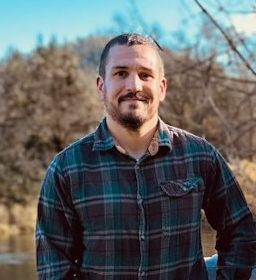
We are excited to have Ricky join the DNR Land Use Unit team as the new Shoreland and Floodplain Planner. Ricky brings a lot of experience to these programs, having previously worked in city and county planning and zoning for nearly a decade in Roseburg, Oregon. His experience working in local government gives him a solid foundation for connecting with communities that administer shoreland and floodplain management ordinances.
In his new role, he will be helping communities amend or adopt new ordinances, and will also serve as the program manager for the Lower St. Croix National Scenic Riverway (LSCR) Program, which includes the lower 52 miles of the St. Croix River (a designated wild and scenic river). This program established minimum regulations for land use, surface water use, and other zoning regulations along the LSCR that are administered through local zoning ordinances. Ricky will join current shoreland and floodplain management staff in our ongoing efforts to ensure effective land use management across the state.
|
By Jamie Schulz, DNR Fisheries GIS Coordinator, MNIT; Jen Sorensen, Public Waters Program Hydrologist, DNR; Sean Vaughn, Lidar Data Stewart, MNIT
Technology in our world is advancing steadily and has crept into almost everything we do. We can’t function without our computers and our phones at home or work. A unique technology known as lidar has become part of everyday life without most users even knowing what it is. For example, robot vacuums identify obstacles in their path using lidar as they map out rooms, smartphones use lidar to measure distance, and autonomous vehicles use lidar to navigate roads.
This article explains what lidar is, how it’s used, how to access Minnesota’s existing (first generation) lidar data, and Minnesota's 3D Geomatics Committee's recent initiative with the U.S. Geological Survey’s 3D Elevation Program (3DEP) to collect new (second generation), statewide lidar. A follow-up article in Water Talk will explain in more detail the improved accuracy and resolution of Minnesota’s second generation lidar and the data products that will be derived from it.
What is Lidar?
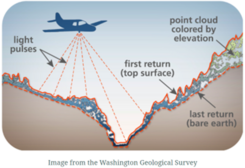
Lidar stands for light detection and ranging. It is a modern remote sensing survey technology that measures distance. Minnesota's statewide lidar is collected using laser pulses sent from instrumentation aboard fixed-wing crewed aircraft to the earth's surface. The pulses reflect from the ground and objects below back to the plane's lidar sensor.
Each captured reflectance is assigned an X, Y, and Z (latitude, longitude, and elevation) coordinate value that locates it to a specific point on an object or on the ground. With technology improvements, lidar has become a feasible and cost-effective way to collect detailed and accurate surface data over large areas.
|

A data set of millions of individually collected data points is called a lidar point cloud, and that data can be used to represent the three-dimensional positions of objects on the surface, like buildings and vegetation.
|
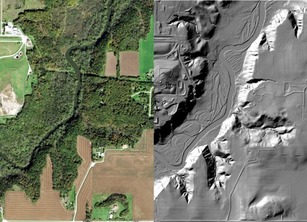
By processing a lidar point cloud and removing points that represent surface objects, a bare earth digital elevation model (DEM) is created. A DEM shows the topographic surface of the earth without vegetation or other surface objects illustrating landscape features not visible in aerial photos. These DEMs are used to create seamless topographic contours of the landscape.
This comparison shows a section of the Cannon River near Faribault. Drainage to the river, the valley slopes, and the river’s twists and turns are clearly shown on the 1-meter DEM on the right, but are not as easy to see on the aerial photo on the left because of the overlying vegetative canopy.
|
How is lidar used?
Lidar is used in a wide range of land management and planning efforts to improve decision-making. Accurate elevation data can be used by local governments for many uses:
- Land use planning
- Infrastructure planning and design
- Site planning and design
- Line of sight analysis
- Stormwater analysis and design
- Floodplain determinations
- Assessing potential for landslides
- Wetland mapping
- And more!
Lidar provides the detailed topography and more accurate elevation data needed for improved floodplain mapping and better flood risk management. When it becomes available, Minnesota’s 3D Geomatics Committee has established a subgroup to serve as a community of practice to bring lidar-derived hydrography (LDH) to Minnesota. To date, this team has built the foundation needed to guide an initiative to replace Minnesota’s 6-decade old hydrography. It’s predicted that this will be a 10-year journey with GIS and lidar technicians working collaboratively with agency hydrography data managers to ensure the products meets the needs of the many programs and the people of Minnesota. LDH will bring harmonization to Minnesota’s authoritative hydrography data. This 3D data will illustrate the flow of water on the ground (rivers, streams, and road ditches) and the locations of constructed crossings with great detail.
Second Generation Lidar Plan

Go to the Minnesota Lidar Plan StoryMap to learn more about lidar, how it is used in Minnesota, and the Minnesota Lidar Plan.
Note: To learn more about Minnesota’s second generation of lidar visit these resources:
How to Access Minnesota's First Generation Lidar Data
|
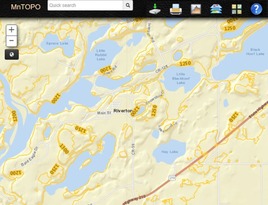
Minnesota’s first generation lidar was collected from about 2008 – 2012 and lidar-derived elevation data is available on the DNR’s easy-to-use MnTOPO web application. The October 2021 Water Talk article MnTOPO Viewer – Review of a Useful Tool explains the basic features of MnTOPO and how to view, print, and download elevation data. Two-foot contours are displayed and tools are available to see point elevations and create topographic profiles.
What is Second Generation Lidar?
|
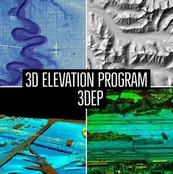
In 2017 Minnesota initiated a new effort to collect lidar statewide. Data collection launched in 2021 and was completed this spring 2024. Now the work to process and create lidar-derived data products will begin. It’s called second generation lidar because advancements in technology since the first statewide lidar was collected about 15 years ago have vastly improved the accuracy and resolution of the data.
Minnesota’s second generation lidar was collected in partnership with the U.S. Geological Survey’s 3D Elevation Program (3DEP). This program is the first nationwide effort to collect seamless high-resolution topographic elevation data that meets national standards. The data is certified through the 3DEP third-party review process, which ensures the data is consistent and authoritative.
First Generation versus Second Generation minimum accuracy requirements
|
| Minnesota Lidar Data |
First Generation
(Collected 2008-2012)
|
Second Generation
(Collected 2021-2024)
|
| Vertical Accuracy |
20 cm |
10 cm |
| Point Density |
> 0.5 points/m2
|
> 8.0 points/m2
|
| Contour Interval |
2-foot |
1-foot |
| DEM Resolution |
1-meter |
0.5 meter |
Data was collected over four years across the state in acquisition blocks (see map). Minnesota’s next generation lidar will serve as foundational data for the development of authoritative statewide 0.5-meter and 1-meter DEMs, hillshades, and 1-foot contour lines. The 3DEP-certified lidar data will also be used for FEMA flood studies and related modeling.
As the above table shows, there are big improvements in accuracy and resolution with this 3DEP lidar data!

Are you interested in joining the DNR Ecological and Water Resources Division? The division is looking to fill a new Floodplain Engineer position in our floodplain and shoreland management programs.
The position will be part of a dedicated team that works with FEMA to create and update quality floodplain models and maps that help Minnesotans understand flood risk. Job duties will include a mix of hydrology and hydraulics modeling, GIS tasks, and database management, in addition to outreach to local communities during the mapping update process.
To apply, go to https://mn.gov/mmb/careers/ and search for “Floodplain Engineer” or Job ID 78327.
Closing date is Aug. 7, 2024.
|
FEMA Region 5 staff (based in Chicago) are continuing their monthly one-hour virtual training series in 2024. They are free!
It's not too late to register for many training topics!
Upcoming "Managing your Community's Floodplain" monthly series dates and topics:

Note: All held 9-10 a.m. Central Time.
-
Aug. 28, 2024: Resolving Potential Violations: Floodway, Low Floor, Vents; Register
-
Sept. 25, 2024: Accessory and Agricultural Structures; Register
-
Oct. 30, 2024: Great Lakes Coastal Floodplain Management; Register
-
Nov. 27, 2024: Natural and Beneficial Functions; Register
-
Dec. 18, 2024: Community Rating System; Register
These trainings and registration links are also available on the DNR Floodplain Training and Education page.
|
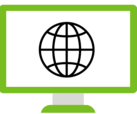
Talk with FEMA and DNR Floodplain Program representatives during monthly virtual Minnesota Floodplain Management Office Hours. Hours are 10-11 a.m., typically on the fourth Thursday of the month (but a few are adjusted to avoid holidays, etc.).
Upcoming monthly hours (Note: all are 10 - 11 a.m. Central Time)
Where: Teams. No registration is required. Select a date to see a Teams meeting and join us.
These office hour dates and links are also available on the DNR Floodplain Training and Education page.
|
Important Dates to Note:
(since June 2024 Water Talk and upcoming in next couple months)
|
|
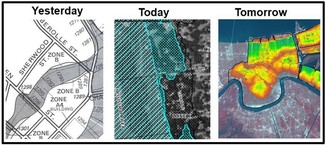 |
Preliminary Maps
None
Local Officials Meetings and Open Houses
None
90-Day Appeal Periods
- Olmsted panels (Rochester levee): June 18 to Sept. 18, 2024
Letters of Final Determination (LFDs)
- Sept. 2024 - Itasca & St. Louis Countywides (anticipated)
Effective (Six months after LFD date)
- July 17, 2024 - Le Sueur Countywide
- July 31, 2024 - Morrison Countywide
- Sept. 12, 2024 - Stevens Countywide
- Sept. 26, 2024 - Dodge Countywide
- Sept. 26, 2024 - Pope Countywide
Additional Map Update Information:
|